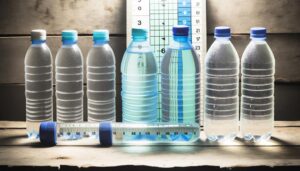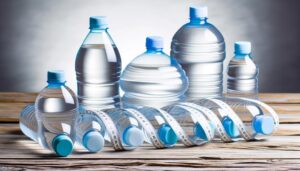Can You Put Beer in a Water Bottle? Yes!
You can put beer in a water bottle, but it’s not optimal. Plastic bottles can affect taste due to chemical leaching and increased oxygen permeability, leading to oxidation.
They’re also not designed for the pressure of carbonated beverages, risking leaks and potential safety issues.
Additionally, unsterilized containers can introduce harmful bacteria, posing health risks. Complying with local laws is essential, as many areas prohibit carrying alcohol in non-original containers.
Keeping beer at the right temperature is another challenge since water bottles lack proper insulation.
There are better alternatives, and understanding these aspects can help you make an informed choice.

Key Takeaways
Taste and Flavor Impact
When you transfer beer into a water bottle, its taste and flavor can be significantly altered due to material interactions and exposure to light.
Plastic water bottles often contain compounds like polyethylene terephthalate (PET), which can leach into the beer, imparting an off-taste.
Additionally, plastic is more permeable to oxygen compared to glass, accelerating oxidation and leading to stale flavors.
Exposure to light, especially ultraviolet (UV) light, can also degrade beer’s hop compounds, causing a ‘skunky’ aroma. Water bottles are typically clear, offering little protection against UV rays.
To preserve beer’s intended taste and aroma, it’s important to take these factors into account. Always store beer in containers designed to maintain its quality, such as dark glass bottles or stainless steel vessels.
Carbonation Concerns
You’ll need to take into account carbonation when transferring beer to a water bottle. Pressure build-up can compromise the bottle’s integrity, especially if it’s not designed to handle carbonation.
Additionally, the material of the water bottle may affect both the retention and longevity of the beer’s carbonation.
Pressure Build-Up Risks
Understanding the potential for pressure build-up due to carbonation is crucial when considering putting beer in a water bottle.
Carbonated beverages like beer release carbon dioxide, which can accumulate and increase internal pressure.
Unlike water, beer’s carbonation exerts force on the container, potentially leading to leaks or even ruptures.
Water bottles are typically designed to hold still liquids, not pressurized ones. If you put beer in a water bottle and seal it tightly, the pressure may exceed the bottle’s structural limits. Consequently, this can result in sudden bursts or gradual deformation.
Always consider the container’s tolerance to pressure and carbonation before making this choice to avoid accidents and maintain the integrity of your beverage.
Container Material Effects
Choosing the right material for your water bottle is crucial to managing the effects of carbonation in beer. Plastic bottles, while convenient, are permeable and can lead to rapid carbonation loss.
On the other hand, glass bottles provide a non-porous barrier, maintaining carbonation more effectively. However, glass is prone to breakage under pressure.
Stainless steel bottles strike a balance by being both durable and impermeable, yet they may alter the beer’s taste over time.
Each material interacts differently with the carbon dioxide in beer, affecting both the beverage’s fizziness and safety.
When deciding, consider the material’s permeability, pressure tolerance, and potential impact on flavor to ensure optimal carbonation retention and overall beer quality.
Carbonation Retention Issues
Maintaining carbonation in beer when using a water bottle presents unique challenges that demand careful consideration of various factors.
Water bottles, often designed for still liquids, may not effectively seal in the carbon dioxide essential for beer’s effervescence. This can lead to the beer going flat much faster than if it were stored in a properly sealed container. While some may wonder, can you store gas in bottles the way carbon dioxide is stored in pressurized tanks, standard water bottles lack the necessary barrier to retain carbonation. As a result, beer stored in them may lose its refreshing fizz within a short time.
You’ll find that plastic bottles are more permeable to gas, leading to rapid carbonation loss. Additionally, the bottle’s shape can influence pressure retention; wide-mouth designs might exacerbate gas escape.
Temperature fluctuations also play an important role, as warmer conditions accelerate CO2 diffusion.
To mitigate these issues, you should secure a tight seal, minimize headspace, and store the bottle in a cool environment.
Understanding these dynamics helps maintain the beer’s intended flavor and fizziness, providing a more satisfying drinking experience.
Material Safety
When you consider putting beer in a water bottle, you need to think about the material’s safety. Plastic can leach chemicals, especially if it’s not BPA-free, potentially affecting the beer’s taste and safety.
Additionally, temperature changes can exacerbate these risks, making it important to analyze how the bottle’s material responds to different conditions.
Plastic Chemical Leaching
Drinking beer from a plastic water bottle could expose you to harmful chemicals that leach from the bottle’s material.
When alcohol interacts with plastic, it can cause chemical compounds like phthalates and antimony to migrate into the liquid.
These chemicals, often used to increase plastic’s flexibility and durability, can disrupt your endocrine system and potentially lead to long-term health issues.
Additionally, plastic degradation accelerates when exposed to alcohol, increasing the rate of chemical leaching.
It’s important to understand that not all plastics are designed to hold alcoholic beverages, and using them incorrectly can pose significant health risks.
Always choose containers specifically designed for alcohol to minimize your exposure to these harmful substances.
BPA-Free Considerations
Selecting BPA-free bottles is vital since bisphenol A (BPA) can leach into beverages and mimic estrogen, potentially resulting in various health issues. If you’re considering putting beer in a water bottle, opting for BPA-free materials is a wise choice.
BPA exposure is linked to hormonal disruptions, which can affect reproductive health and increase cancer risk.
Here’s a quick comparison of bottle materials:
| Material | BPA-Free? | Durability |
|---|---|---|
| Polycarbonate | No | High |
| Tritan | Yes | High |
| Stainless Steel | Yes | Very High |
| Glass | Yes | Moderate |
| PET Plastic | Yes | Low |
These considerations are essential for ensuring your beer remains uncontaminated and safe to drink. Always check product specifications for BPA-free labels when selecting a suitable container.
Temperature Impact Analysis
Understanding how different materials react to temperature changes is crucial for ensuring the safety and integrity of your beer in a water bottle.
Plastic bottles, especially those not designed for hot or cold extremes, can compromise your beer’s quality and safety.
Here’s a breakdown:
- Plastic Deformation: At high temperatures, plastic can warp or melt, releasing harmful chemicals into your beer.
- Thermal Insulation: Plastic lacks the insulating properties of materials like stainless steel, making it harder to maintain ideal beer temperature.
- Expansion and Contraction: Repeated temperature fluctuations can cause plastic to expand and contract, leading to potential leaks and structural weaknesses.
Understanding these factors helps you make an informed decision about using water bottles for beer storage, ensuring both taste and safety.
Legal Considerations
You should be aware that local laws and regulations often dictate whether you can legally carry beer in a water bottle in public spaces.
In many jurisdictions, open container laws specifically prohibit the public possession of alcohol in anything other than its original packaging. This means transferring beer to a water bottle could result in fines or legal repercussions.
Additionally, some areas implement restrictions on consuming alcohol in public, regardless of the container used.
To guarantee compliance, you’ll need to familiarize yourself with the specific regulations of your locality.
Avoiding legal pitfalls requires diligent research and adherence to the rules. Always prioritize understanding and following the law to minimize any risk of legal issues.
Health Risks
Transferring beer to a water bottle can introduce health risks due to potential contamination and the absence of proper sterilization.
When you pour beer into an unsterilized container, it can pick up harmful bacteria and other pathogens.
Even if the water bottle looks clean, microscopic contaminants can still be present. These can multiply rapidly, especially if the bottle isn’t properly sealed.
Consider these potential health risks:
- Bacterial Growth: Bacteria such as E. coli and Salmonella can thrive in non-sterile environments, leading to severe gastrointestinal issues.
- Chemical Leaching: Some plastic water bottles contain chemicals like BPA, which can leach into your beer and pose long-term health risks.
- Cross-Contamination: Residues from previous liquids can mix with your beer, creating unintended and possibly dangerous chemical reactions.
Temperature Maintenance
Maintaining the ideal temperature for beer is crucial for preserving its flavor and carbonation. When you put beer in a water bottle, temperature management becomes challenging.
Water bottles generally lack the insulating properties that specialized beer containers possess. Beer should be kept at a consistent temperature, typically between 45-55°F for most styles.
Without proper insulation, the beer can quickly warm up, leading to a loss of carbonation and altered taste profiles.
Additionally, frequent temperature fluctuations can cause the beer to go flat or develop off-flavors. If you’re determined to use a water bottle, consider wrapping it in insulating material or storing it in a cooler.
However, for best results, using a purpose-designed beer container is recommended.
Convenience Factor
While temperature management poses a challenge, the convenience of using a water bottle for beer can’t be overlooked.
You’ll find that water bottles are lightweight, unbreakable, and easy to carry. This makes them ideal for various situations where traditional beer containers fall short.
Consider the following:
- Portability: Water bottles fit in most bag side pockets and cup holders, making them easy to transport.
- Durability: Unlike glass bottles, water bottles won’t shatter if dropped.
- Discretion: If you need to be subtle, water bottles don’t draw attention like beer cans or bottles.
These points make water bottles a practical choice for beer, particularly in environments where glass is impractical or prohibited.
Alternative Solutions
For those seeking alternatives to water bottles for beer, consider options like insulated growlers, stainless steel pint cups, or specialized beer canisters that offer better temperature control and maintain carbonation.
Insulated growlers can keep your beer cold for hours and often come with airtight seals to preserve freshness.
Stainless steel pint cups are durable and portable, making them ideal for outdoor activities.
Specialized beer canisters, designed specifically for maintaining carbonation, guarantee that your beer retains its effervescence.
Each of these alternatives provides a superior drinking experience compared to water bottles, which often fail to uphold the beer’s quality.
By investing in the right container, you’ll enjoy your beer at its best, whether you’re at a picnic, camping, or just relaxing at home.
Conclusion
Imagine taking a sip from a water bottle filled with beer, only to find it warm, flat, and tasting of plastic. You’d miss the crisp carbonation and fresh flavor.
Safety concerns arise as some plastics may leach harmful chemicals. Legally and health-wise, it’s a gray area.
While convenient, the risks far outweigh the benefits. Instead, consider portable alternatives like insulated growlers to keep your beer cold and flavorful, ensuring an enjoyable experience.






